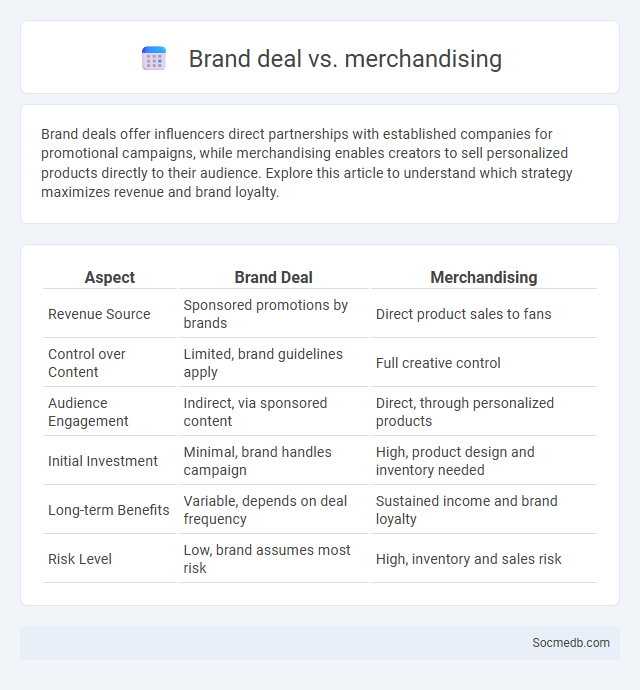
Photo illustration: Brand deal vs Merchandising
Brand deals offer influencers direct partnerships with established companies for promotional campaigns, while merchandising enables creators to sell personalized products directly to their audience. Explore this article to understand which strategy maximizes revenue and brand loyalty.
Table of Comparison
| Aspect | Brand Deal | Merchandising |
|---|---|---|
| Revenue Source | Sponsored promotions by brands | Direct product sales to fans |
| Control over Content | Limited, brand guidelines apply | Full creative control |
| Audience Engagement | Indirect, via sponsored content | Direct, through personalized products |
| Initial Investment | Minimal, brand handles campaign | High, product design and inventory needed |
| Long-term Benefits | Variable, depends on deal frequency | Sustained income and brand loyalty |
| Risk Level | Low, brand assumes most risk | High, inventory and sales risk |
Understanding Brand Deals: A Comprehensive Overview
Brand deals on social media involve collaborations between influencers and companies to promote products or services, leveraging the influencer's reach and engagement to boost brand visibility and sales. These partnerships can include sponsored posts, product placements, and affiliate marketing, with clear disclosure policies to maintain transparency and trust with the audience. Understanding contract terms, audience demographics, and content guidelines is vital for maximizing the effectiveness and compliance of brand deals in digital marketing campaigns.
What is Merchandising? Definitions and Key Concepts
Merchandising is the strategic practice of promoting and selling products through various channels, including social media, to enhance brand visibility and drive sales. Key concepts include product presentation, targeted promotions, and customer engagement, all designed to influence purchasing decisions. Your understanding of merchandising on social media helps optimize content and advertising strategies to maximize conversion rates and revenue.
Brand Deals vs Merchandising: Core Differences
Brand deals involve collaborations between influencers and companies where the influencer promotes products or services in exchange for payment or commissions, emphasizing reach and audience engagement. Merchandising centers on influencers creating and selling their own branded products directly to fans, prioritizing ownership, profit margins, and long-term brand loyalty. While brand deals capitalize on existing audiences and external products, merchandising builds personal brand equity through tangible goods.
Revenue Streams: Comparing Earning Potential
Social media platforms generate revenue primarily through advertising, subscription services, and direct monetization features such as in-app purchases and creator funds. Facebook's advertising revenue exceeded $115 billion in 2023, showcasing the dominance of ad-based income, while platforms like YouTube and Twitch leverage creator subscriptions and donations to diversify earnings. Emerging models such as TikTok's creator fund and Instagram's shopping features highlight shifting strategies to enhance user engagement and maximize platform profitability.
Control and Creative Freedom in Brand Deals and Merchandising
Maximizing control and creative freedom in brand deals and merchandising empowers you to align collaborations with your authentic voice and audience preferences. Leveraging social media platforms' analytic tools helps tailor content strategies that boost engagement and ensure brand consistency. Strategic negotiation of partnerships preserves your creative autonomy while optimizing monetization through exclusive merchandise lines.
Risk Analysis: Financial and Reputational Factors
Social media platforms present significant financial risks, including potential costs from data breaches, regulatory fines, and cybercrime. Your brand reputation can be severely impacted by negative publicity, misinformation, or user-generated content, leading to customer distrust and loss of revenue. Conducting a thorough risk analysis helps identify vulnerabilities and develop strategies to protect both your financial assets and brand integrity.
Branding Impact: Building Long-Term Value
Social media platforms significantly enhance branding impact by fostering continuous audience engagement and strengthening brand recognition. Consistent content delivery and authentic interactions on channels like Instagram, Facebook, and LinkedIn contribute to building long-term brand loyalty and credibility. Leveraging analytics and user feedback allows brands to refine their identity, resulting in sustained market value and competitive advantage.
Audience Engagement: Which Strategy Works Best?
Maximizing audience engagement on social media requires understanding your target demographic and tailoring content to their preferences and behaviors. You should prioritize interactive formats such as polls, live videos, and user-generated content to foster authentic connections and boost participation rates. Analyzing platform-specific metrics consistently helps refine your strategy to deliver relevant, timely interactions that resonate with your audience.
Case Studies: Success Stories in Both Approaches
Case studies of social media highlight your ability to generate significant engagement and brand growth through both organic strategies and paid advertising campaigns. Successful examples include companies leveraging targeted content creation to build loyal communities, while others increase reach rapidly using precise audience segmentation in paid ads. Analyzing these success stories reveals best practices for balancing authentic interaction with data-driven promotion to maximize social media impact.
Choosing the Right Path: Brand Deal or Merchandising?
Choosing the right monetization strategy on social media depends on audience engagement and brand alignment. Brand deals offer immediate revenue through partnerships with companies that match your content style, while merchandising builds long-term value by creating personalized products for loyal followers. Evaluating follower demographics, content niche, and revenue goals helps determine whether sponsored collaborations or custom merchandise yield the best return on investment.
 socmedb.com
socmedb.com